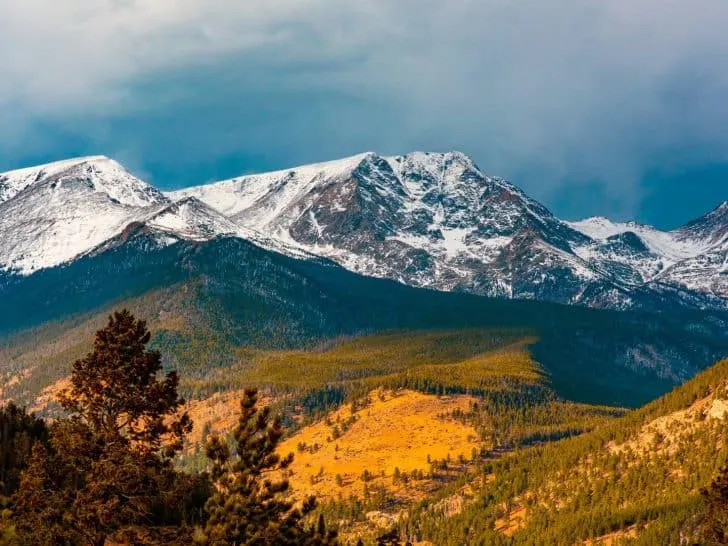Denver has long been known as a launching off point for outdoor adventures, but did you know there are 15 national parks near Denver that can all be reached within six hours, making them excellent day trip or weekend getaways?
These parks are as diverse as the state of Colorado, protecting alpine wonderlands, pioneer history, huge sand dunes, and so much more. Here is your guide to the national park units near Denver, along with driving distance and tips on what to do in each park.
15 Amazing National Parks Near Denver
Rocky Mountain National Park
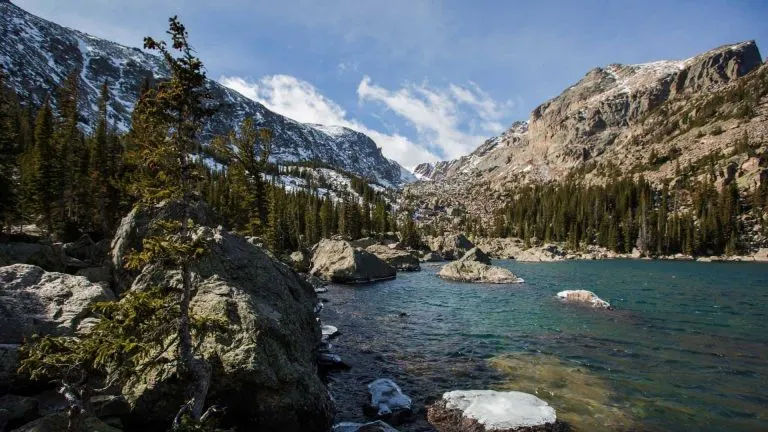
Distance from Denver: 66.4 miles (~90 minutes)
The closest national park to Denver is Rocky Mountain National Park, a wonderland of high peaks, azure lakes and waterfalls, and a variety of wildlife.
While the park is open year-round, some portions of the park are only open during the summer due to snowfall. Trail Ridge Road, one of the parks main highlights that winds up to nearly 13,000 feet in elevation, typically doesn’t open until Memorial Day.
Rocky Mountain National Park is a hiker’s paradise. Trails lead to alpine lakes, cascading waterfalls, jagged peaks, and wildflower-dotted tundra.
One of the most popular spots to hike is the Bear Lake Road area. As a matter of fact, it is so popular that the National Park Service has began implementing a timed entry permit reservation system for the peak season of May 26 through October 22. The only way to get around this is to arrive before 5am or after 6pm.
There are also Park Access Timed Entry Permits for those driving over Trail Ridge Road or visit any area of the park located outside of the Bear Lake Road Corridor between the hours of 9am and 2pm from May 26 through October 22nd.
In the Bear Lake area, the hike to Nymph Lake, Dream Lake and Emerald Lake is a great option for families. The entire hike is 3.6 miles in length, but is broken up by visits to three different lakes. Of course, Bear Lake is also a popular destination and a half-mile loop trail encircles the lake.
The trail to Alberta Falls is another that most won’t want to miss. It is just 0.8 miles from the Glacier Gorge parking lot. If you want to continue on for 2.3 miles further, you will come to the Loch, a lovely alpine lake that is an ideal picnic spot. Sky Pond is even further (about 10 miles round trip) and truly is an epic (but challenging) hike for families with teens.
Read our full guide to hiking in Rocky Mountain National Park.
If you are hoping to see moose, hang out at Sprague Lake and Lily Lake on the east side of the park, especially at sunrise or sunset. On the west side, Moose are often seen near the Coyote Valley Trail. Elk are most offten seen in and around the gateway town of Estes Park as well as inside the park at the lower elevations.
Estes Park made our guide to the best mountain towns in Colorado. See what other towns made the list!
Florissant Fossil Beds National Monument
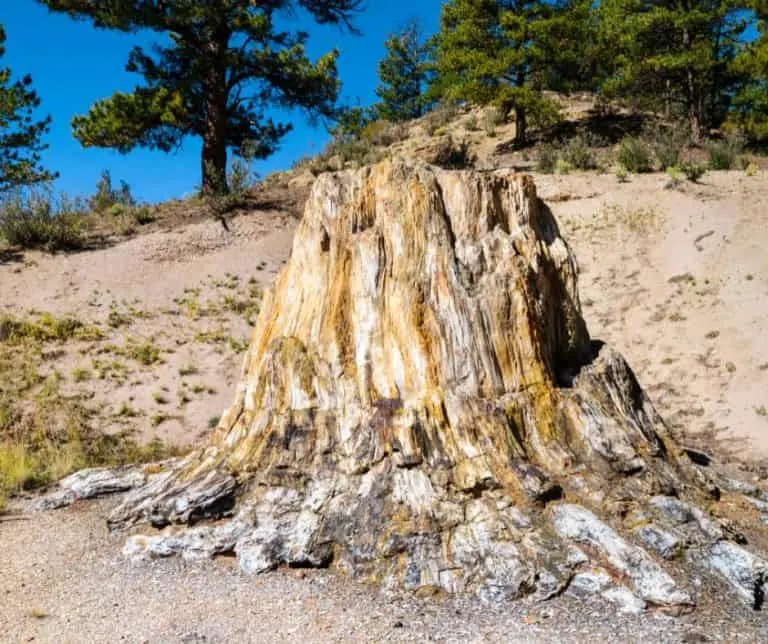
Distance from Denver: 104 miles (~ 2 hours)
Florissant Fossil Beds National Monument is located two hours southeast of Denver and is known for its petrified forest that dates back millions of years. Here, visitors can witness the unique geological processes that occurred during the late Eocene era. You can see everything from insects to giant redwood trees that were buried by volcanic ash millions of years ago.
The visitor center is the best place to start your trip and has a museum where you can view various fossils and learn about the plants and animals that lived in the area during the Eocene epoch.
There are 14 miles of trails inside the monument, and one of the most popular trails is the one-mile Petrified Forest Loop which takes visitors through a forest of petrified stumps and logs. One of the major highlights on this trail is Big Stump, one of the biggest petrified tree stumps on Earth.
The Geologic Trail is a short trail where walkers can learn about a billion years of geologic history in the Florissant Valley as it crosses over an ancient lake bed. Another popular trail is the Hornbek Homestead Trail, which leads to the historic Hornbek Homestead, a log cabin that was built in the late 1800s.
Explore more of the state! Here are our favorite things to do in Colorado with kids.
Browns Canyon National Monument

Distance from Denver: 125 miles (2 hours, 20 minutes)
Browns Canyon National Monument is a stunning outdoor destination located in the heart of Colorado. This protected area, established in 2015, spans over 21,000 acres and offers visitors an array of outdoor activities, including hiking, camping, fishing, and rafting.
One of the most popular activities in Browns Canyon National Monument is whitewater rafting. The Arkansas River runs through the park and offers a range of rapids for all skill levels. You can choose between half-day, full-day, or multi-day rafting trips and enjoy breathtaking views of the canyon and surrounding mountains while navigating the river.
There are several hiking trails in the park that offer views of the canyon and its unique rock formations. Take the hike to the Browns Canyon Overlook Trail, a 1.5-mile hike that leads to a panoramic view of the Arkansas River Valley.
Browns Canyon National Monument is also an excellent destination for fishing enthusiasts. The Arkansas River is home to rainbow and brown trout, and there are several access points throughout the park. Fishing permits are required and can be purchased at local outfitters or online.
Bent’s Old Fort National Historic Site
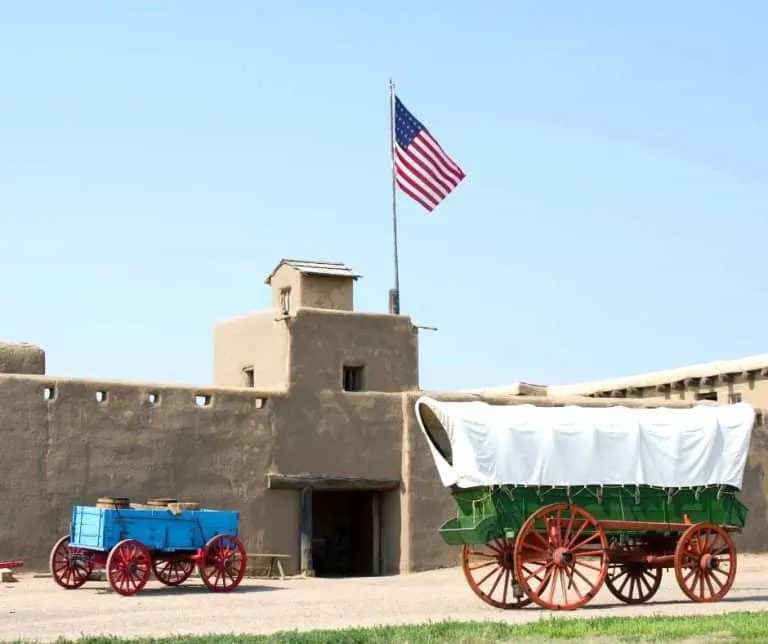
Distance from Denver: 184 miles ( 3 hours)
Bent’s Old Fort National Historic Site is a great destination for those interestested in learning about the Old West. Located near La Junta, this reconstructed adobe fort was originally established in 1833 as a trading post on the Santa Fe Trail. Today, visitors can step back in time and experience what life was like on the western frontier during the 1800s.
First head to the visitor center and learn about the history of the fort through exhibits and artifacts. Guided tours are also available, led by knowledgeable rangers who provide insights into the daily lives of the fort’s inhabitants, including traders, soldiers, and Native Americans.
There are also demonstrations of traditional trades, such as blacksmithing and carpentry, as well as daily tasks like cooking and laundry. Additionally, visitors can experience the fort’s rich cultural heritage through traditional music and dance performances by Native American tribes.
Visitors can even shop for souvenirs and handcrafted items at the fort’s trading post, which offers a wide range of goods, from pottery and jewelry to books and toys.
Sand Creek Massacre National Historic Site
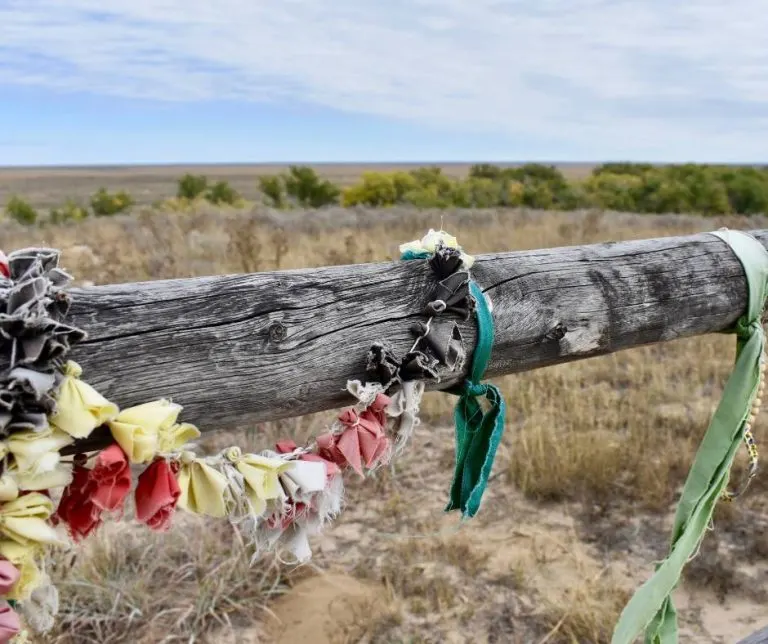
Distance from Denver: 183 miles (3 hours)
Visiting Sand Creek Massacre National Historic Site is a moving and educational experience. The site is located in southeastern Colorado and commemorates the tragic events that took place there on November 29, 1864.
The site is dedicated to preserving and sharing the stories of the Cheyenne and Arapaho people who were massacred by the U.S. Army in what is now recognized as one of the darkest moments in American history.
Upon arrival, visitors can watch a short video that provides an overview of the history of the massacre and the site. They can then take a self-guided walking tour of the grounds, which include a small museum and interpretive signs that tell the story of the massacre and its aftermath.
One of the most powerful aspects of visiting Sand Creek Massacre National Historic Site is the opportunity to hear from the descendants of those who were killed. There are often Native American speakers and educators on-site who offer personal insights and perspectives on the event and its impact on their communities.
It is important to note that the site is sacred to the Cheyenne and Arapaho people, and visitors are asked to show respect and reverence for the site and its history.
Fort Laramie National Historic Site

Distance from Denver: 211 miles (3 hours, 15 minutes)
Fort Laramie National Historic Site in southeastern Wyoming is another great national park site within a few hours of Denver that preserves the history of the Old West. This site protects the remains of an 1800s military outpost that played a crucial role in the westward expansion of the United States.
Visitors to Fort Laramie can explore the restored buildings, including the officers’ quarters, barracks, and commissary, and get a feel for what life was like at the fort in the mid-19th century. The park rangers offer guided tours of the site, and there are plenty of interpretive signs and exhibits to help visitors learn about the history of the fort.
This park also preserves the original wagon ruts from the Oregon Trail, which runs through the park. Visitors can walk along the trail and imagine what it must have been like for the thousands of pioneers who traveled westward on foot or in covered wagons.
Curecanti National Recreation Area
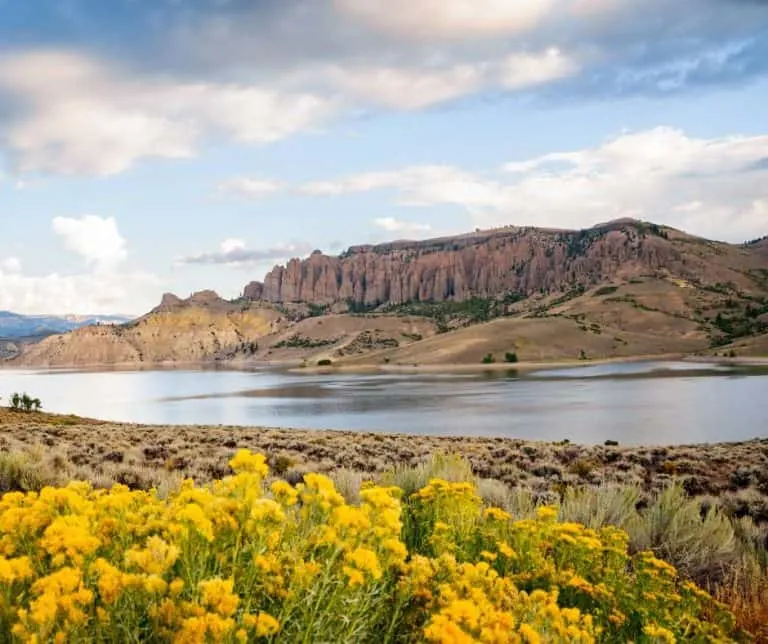
Distance from Denver: 216 miles (~ 4 hours)
Curecanti National Recreation Area covers a vast area of 43,000 acres, featuring three reservoirs, over 200 miles of shoreline, and numerous hiking trails that lead to scenic vistas in Colorado’s Rocky Mountains southwest of Denver.
The park’s three reservoirs, Blue Mesa, Morrow Point, and Crystal, are excellent for water sports activities such as fishing, kayaking, canoeing, and boating. Visitors can rent boats or bring their own.
The Recreation Area is located on the Gunnison River and includes portions of the Black Canyon of the Gunnison that are not inside the National Park. The National Park Service does operate a boat tour of Morrow Point which leads visitors to portions of the canyon where walls extend up 1,000 feet on either side, but the tours are unfortunately not operating in 2023.
The park has a network of hiking trails that cater to all levels of difficulty and do allow leashed dogs. One of the park’s most popular hikes is the Dillon Pinnacles Trail, which offers wonderful views of the Dillon Pinnacles rock formations. It is four miles round trip and does involve 600 feet in elevation change.
The Pine Creek Trail (two miles) alllows you to walk along the old narrow gauge railroad bed along the Morrow Point Reservoir. There are interpretive signs along the trail that share the history of the area.
Scotts Bluff National Monument

Distance from Denver: 195 miles (3 hours, 10 minutes)
Scotts Bluff National Monument, located in western Nebraska, offers visitors a glimpse into the history of westward expansion and the pioneers who traversed the Oregon, California, and Mormon Trails.
The visitor center houses a wealth of information about the history and natural features of the area. Visitors can learn about the geology of the region, the indigenous peoples who once inhabited the area, and the pioneers who passed through on their way west. The visitor center also offers interactive exhibits and displays that are great for kids.
The Oregon Trail Museum offers a glimpse into what life was like for pioneers on the trail and includes displays of original wagons, tools, and equipment used by the pioneers. The museum also offers guided tours of the historic trails and landmarks in the area.
There are also hiking trails that take visitors up to the top of the bluff. The trails offer views of the surrounding landscape and a chance to experience the unique ecosystem that exists at the top of the bluff.
Along the way, visitors can also explore the historic structures and sites that dot the trails, including an old pioneer cemetery and the remnants of the historic Fort Mitchell.
Amache National Historic Site
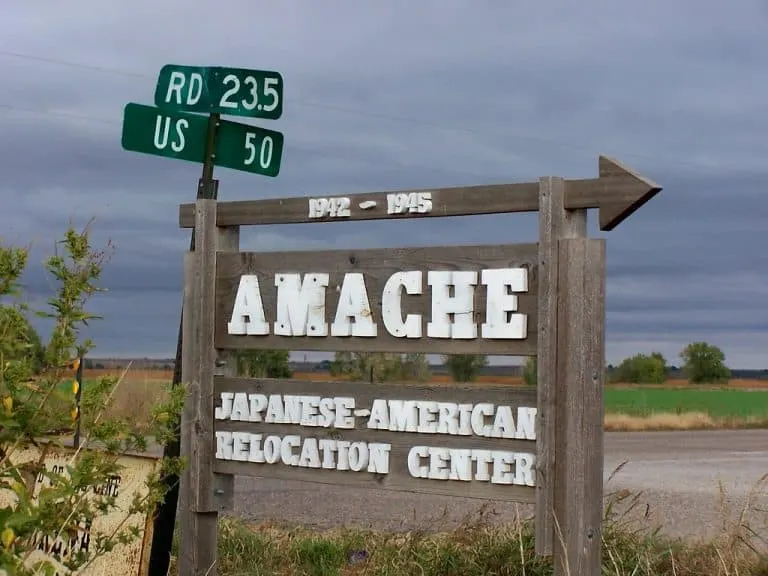
Distance from Denver: 225 miles (3 1/2 hours)
Amache National Historic Site is located in southeastern Colorado and was once home to over 7,000 Japanese Americans who were forcibly interned during World War II. This dark chapter in American history should never be repeated, which is why educating children about what happened is so important.
Visitors can explore the remains of the internment camp, which include several reconstructed buildings, including a mess hall and barracks, as well as interpretive exhibits that offer insight into the experiences of the people who were held here.
Guided tours of the camp are the best way to experience this national historic site. These tours provide insight into life in the camp, including the daily routines of the internees, the challenges they faced, and the ways in which they tried to maintain a sense of community and dignity despite the harsh conditions.
Great Sand Dunes National Park
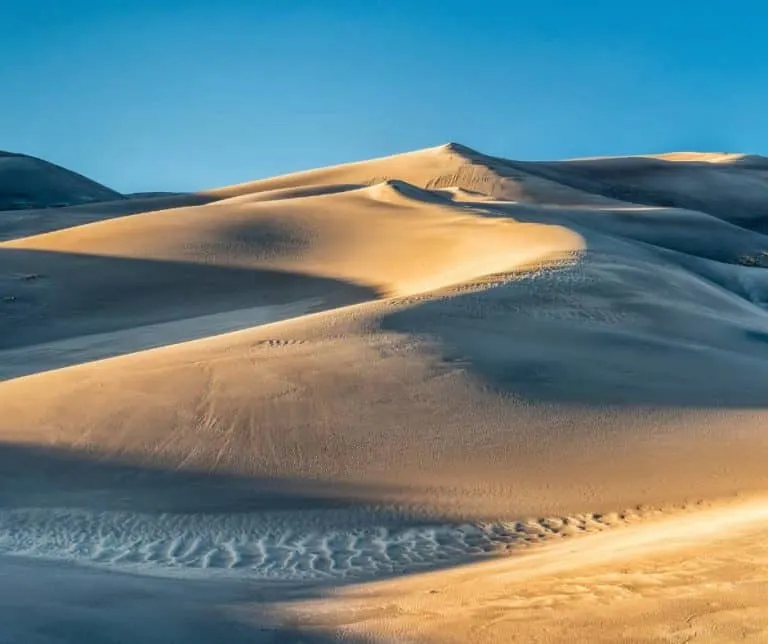
Distance from Denver: 235 miles (3 hours, 40 minutes)
Great Sand Dunes National Park is a unique and impressive destination in the southern portion of the state. The park features the tallest sand dunes in North America, reaching heights of over 750 feet. Visitors can hike to the top of the dunes for an incredible panoramic view of the surrounding landscape.
One of the best ways to experience the dunes with kids is by sledding or sandboarding down the slopes. The park does not provide rental equipment, so be sure to bring your own or rent from a nearby shop.
In addition to the dunes, the park also features the seasonal Medano Creek, which runs along the base of the dunes. During the summer months, visitors can splash around in the shallow creek or build sandcastles on its banks. May and June are busy but are also the best times to enjoy the creek before the mosquitos get bad.
If you are looking to hike, check out Mosca Pass which is forested and offers great views of the sand dunes.
Black Canyon of the Gunnison National Park
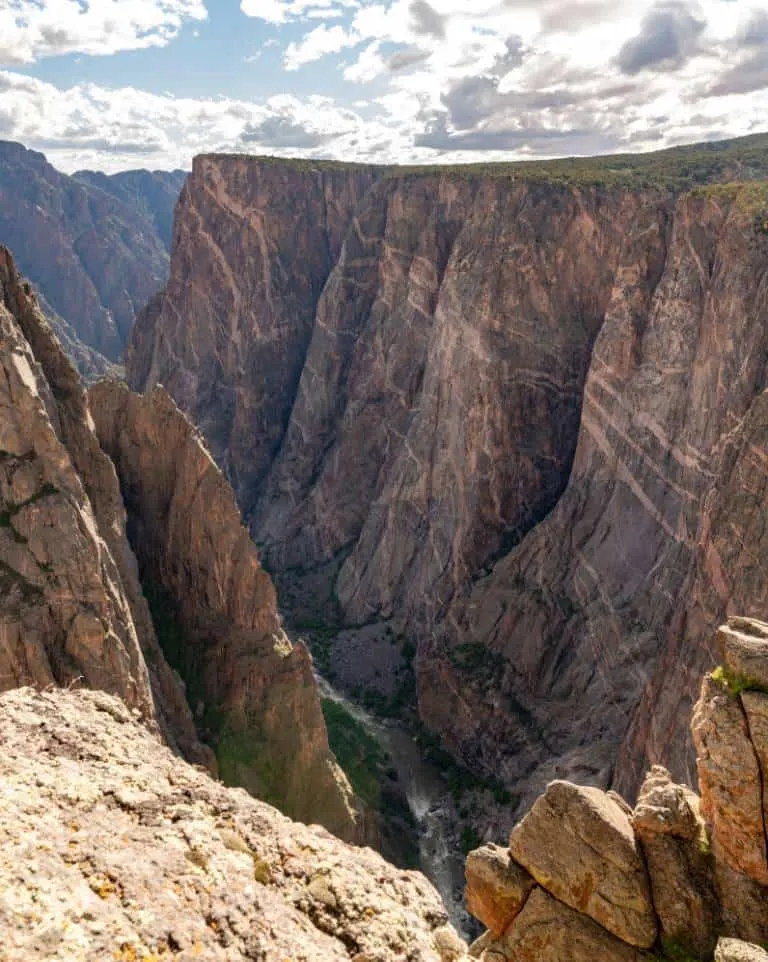
Distance from Denver: 250 miles (~ 5 hours)
Black Canyon of the Gunnison National Park is home to sheer cliff walls which drop 2,000 feet down to the Gunnison River. The river has been carving these ancient walls for two million years!
Hiking is popular in this park which has over 80 miles of trails, ranging from easy nature walks to extremely strenuous hikes that wind down to the canyon floor. The Rim Rock Nature Trail is a great option for families, with interpretive signs explaining the geology and wildlife of the area.
Scenic drives are a great way to enjoy this park. The South Rim Drive is a popular route that takes you along the top of the canyon, with several overlooks where you can stop and take in the views. It is seven miles in length and has 12 different overlooks to enjoy.
The North Rim Drive is less crowded and the views are even more impressive as this rim of the canyon is almost entirely vertical. It is accessed via a gravel road on the eastend of Crawford State Park. Both scenic drives are closed during the winter due to snowfall.
Capulin Volcano National Monument
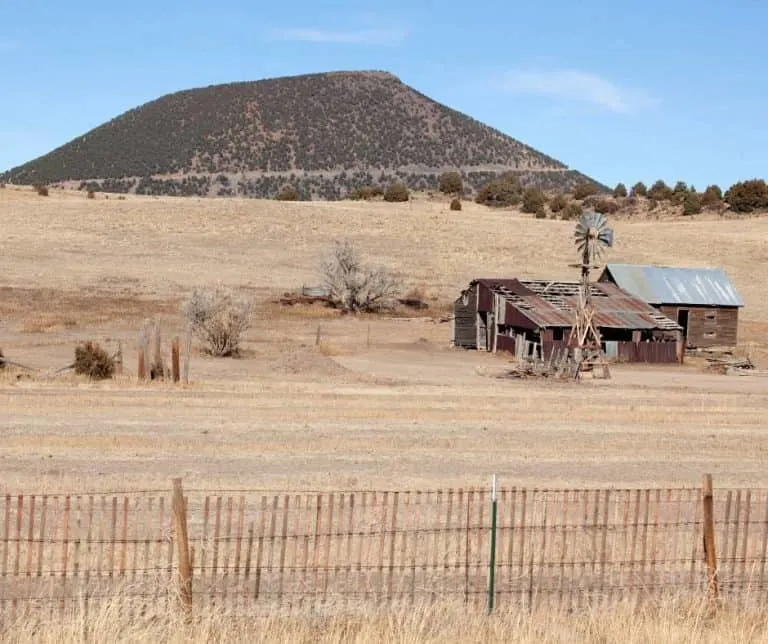
Distance from Denver: 253 miles (3 hours, 45 minutes)
Capulin Volcano National Monument is a lesser known national park unit in northeastern New Mexico. This unique monument offers visitors the opportunity to explore a perfectly symmetrical, extinct volcano that last erupted approximately 60,000 years ago.
The volcano is the centerpiece of the monument, and visitors can take a paved road to the top to enjoy views of the surrounding landscape. At the top, you can walk along the rim trail to enjoy panoramic vistas of the volcanic field and the Rocky Mountains in the distance.
The park is also a great place for stargazing. Its remote location, clear skies, and minimal light pollution make it an ideal location for viewing the stars. The park regularly hosts stargazing events, so be sure to check the schedule during your visit.
Colorado National Monument
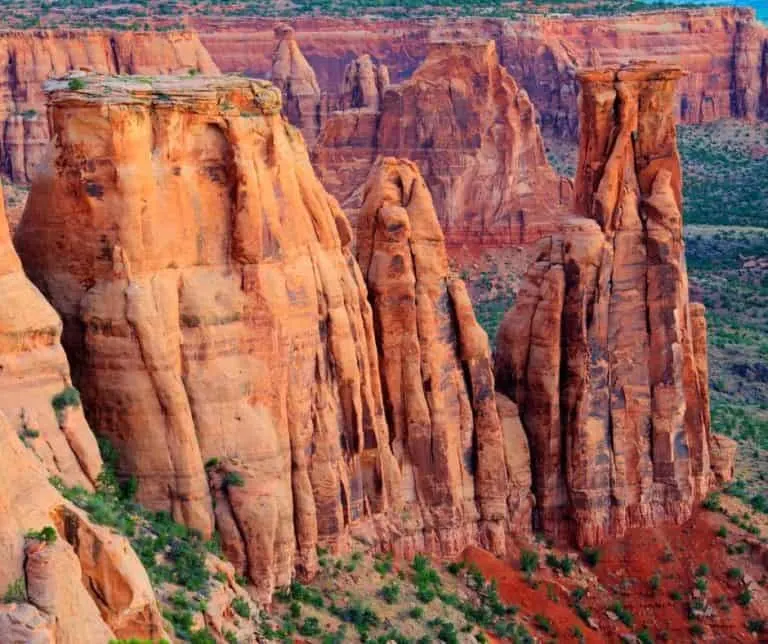
Distance from Denver: 258 miles ( 4 1/2 hours)
Colorado National Monument is located on the western side of the state near Grand Junction. The park is known for its spectacular red rock formations and desert landscape that is drastically different than what you are used to encountering in the Front Range. Some of the best views of the Colorado Plateau and the Rocky Mountains can be enjoyed here.
Begin your visit by taking a scenic drive along Rim Rock Drive, which is a 23-mile-long road that winds through the heart of the park. Along the way, you will be treated to some of the most incredible views of the park’s canyons, rock formations, and mountains.
Colorado National Monument has over 20 miles of hiking trails that will take you through canyons, over ridges, and up to stunning vistas. One of the most popular trails in the park is the Canyon Rim Trail which follows the cliff edge for a half mile and offers impressive views of Window Rock, Wedding Canyon, and Monument Canyon.
The Devil’s Kitchen Trail is popular with families because it leads to a natural opening formed by a circle of huge upright boulders. It is only 1.5 miles round trip and the kids will have a blast climbing around on the rocks.
Dinosaur National Monument
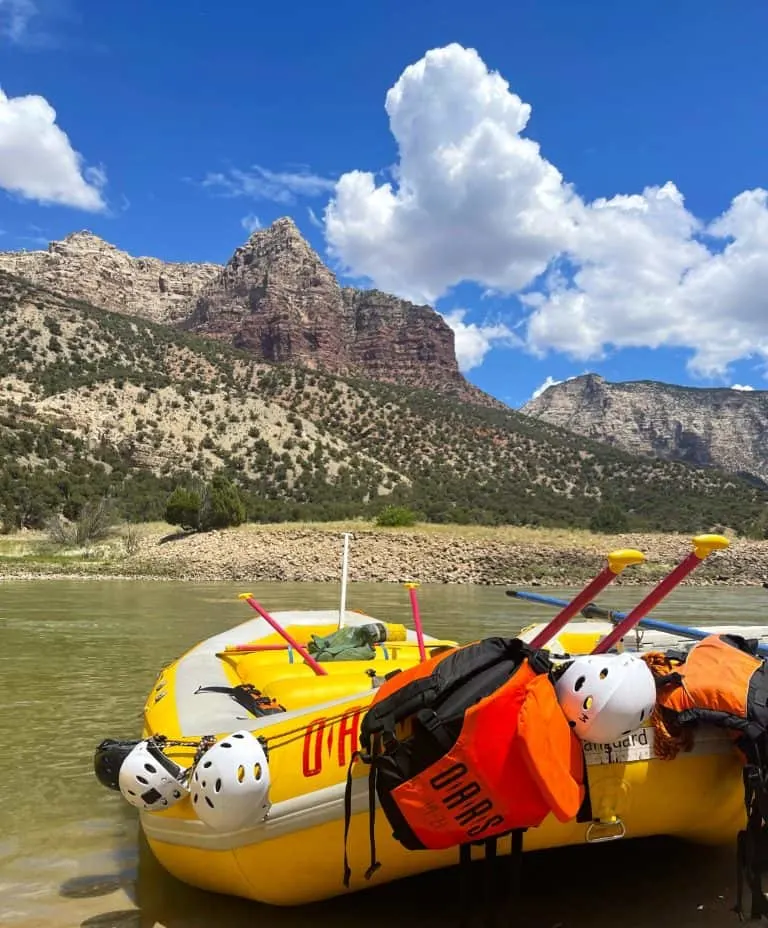
Distance from Denver: 285 miles (~5 hours)
Dinosaur National Monument is a great destination for those who are fascinated by prehistoric creatures as well as those interested in enjoying the natural beauty of the American West. Located in northwestern Colorado and northeastern Utah, the park is famous for its impressive collection of dinosaur fossils and its remarkable scenery.
The Quarry Exhibit Hall is the main attraction, where visitors can see a wall of more than 1,500 dinosaur bones from several different species that were found in the area. The exhibit hall also features interactive exhibits and educational displays about the history of the area and the science of paleontology.
The Canyon Area of the park offers plenty of opportunities for outdoor adventures. Hiking trails wind through stunning canyons and along the Green and Yampa Rivers, but in my experience the best to enjoy the canyon is on one of many river rafting trips being offered in the area.
There are trips that are just one day in length on the Green River that have splashy but easy rapids and incredible scenery, as well as opportunities to see wildlife like desert bighorn sheep clinging to the steep canyon edges and golden eagles soaring above.
Longer trips (3-5 days) are offered on both the Yampa River and Green River which cut through Dinosaur National Monument. OARS is our favorite rafting company. They provide excellent guides that work well with families.
In addition to rafting and dinosaurs, this park also features several important sites related to the Ute tribe, who have lived in the area for thousands of years. Visitors can learn about their history and culture at the Josie Morris Cabin and the petroglyph panels found throughout the park.
Arches National Park
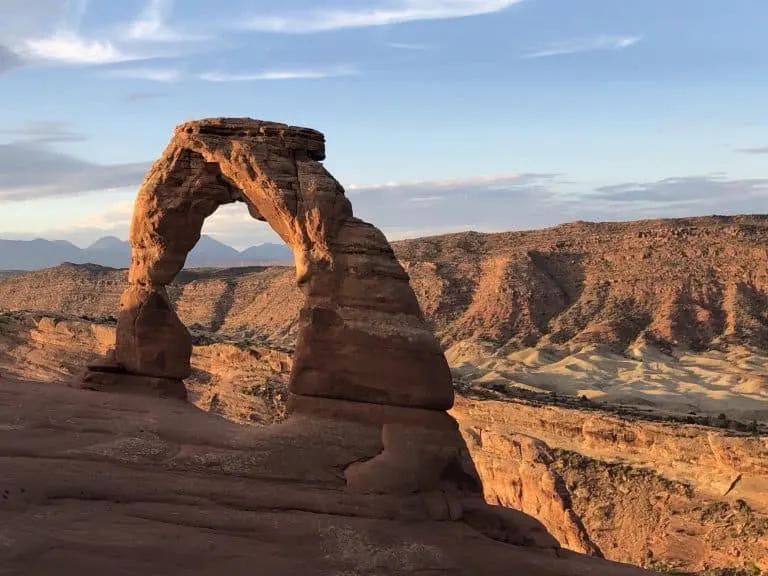
Distance from Denver: 350 miles (5 1/2 hours)
Arches National Park in Utah is a wonderland of red rock formations, arches, and stunning landscapes that are sure to leave visitors in awe. The park is located just a few miles north of Moab, making it a popular destination for outdoor enthusiasts and nature lovers.
Arches National Park has more than 2,000 natural sandstone arches, making it a hiker’s paradise. One of the most popular hikes is the Delicate Arch Trail, which is a three-mile round trip hike that takes you to the iconic Delicate Arch. We suggest you take this hike close to sunrise, especially during the summer when temps are high becuase there is no shade.
Another trail your won’t want to miss is the 1.6-mile round trip hike to Landscape Arch, the longest arch in the world.
If hiking isn’t your thing, there are plenty of scenic drives in the park that offer breathtaking views of the landscapes. The park’s main road, which is 18 miles round trip, takes you to many of the park’s major attractions, including Balanced Rock, Double Arch, and the Windows Section.
Keep in mind that timed reservations are required April 1st through October 31st during the hours of 7 am to 4 pm.
Read our full guide to visiting Arches National Park with kids and check out our Utah National Parks Road Trip itinerary.
- RV 101- Which Type of RV is Right for Your Family? - July 25, 2024
- Over 40 Cool Things to do near Yosemite on a Family Vacation - June 29, 2024
- Airstream Glamping Near Yosemite- My Autocamp Yosemite Review - June 7, 2024

